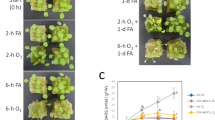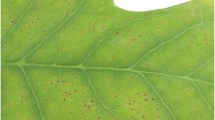Abstract
The accumulation of aromatic secondary metabolites is a well-known element of the plant response to ozone. Most of these metabolites are synthesized via the three aromatic amino acids phenylalanine, tyrosine and tryptophan. Before branching, the biosynthetic pathway to the three amino acids shares seven enzymatic steps, called the prechorismate pathway, catalysed by 3-deoxy-D-arabino-heptulosonate-7-phosphate (DAHP) synthase [EC 2.5.1.54], 3-dehydroquinate synthase [EC 4.2.3.4], 3-dehydroquinate dehydratase [EC 4.2.1.10]-shikimate 5-dehydrogenase [EC 1.1.1.25], shikimate kinase [EC 2.7.1.71], 5-enolpyruvylshikimate 3-phosphate synthase [EC 2.5.1.19] and chorismate synthase [EC 4.2.3.5]). We have studied the transcript level of these enzymes and the aromatic metabolite profile in the ozone sensitive tobacco cultivar BelW3 (Nicotiana tabacum L. cv Bel W3), when exposed to an acute ozone pulse (160 nl l−1, 5 h). Specific cDNA-fragments of the corresponding six genes were isolated from tobacco Bel W3 and used as probes for determining the expression of the prechorismate pathway genes. The fully expanded leaves of ozone treated plants, which developed symptoms like necrotic leaf spots and accumulation of aromatic metabolites, showed a clear induction of the shikimate pathway genes; indicating, that this induction is linked to the development of the symptoms. Distinct kinetics and magnitudes were observed in tobacco leaves for the ozone dependent enhanced mRNA accumulation of the aforementioned genes in BelW3. The strongest and earliest induction due to ozone treatment could be observed for DAHP synthase. An isoform-specific analysis of the transcripts showed a strong induction on transcript level only for one of three isoforms, which was followed by the induction of the DAHP synthase also on protein level. The different induction kinetics of the prechorismate pathway genes indicate that their regulation in response to ozone might be regulated by different signals, for example, ethylene, reactive oxygen species or salicylic acid, which also occur with different kinetics and thus may play different roles in the plant response to ozone.





Similar content being viewed by others
Abbreviations
- DAHPS:
-
3-Deoxy-D-arabino-heptulosonate-7-phosphate synthase
- DHQS:
-
3-Dehydroquinate synthase
- DHQ-SDH:
-
3-Dehydroquinate dehydratase-shikimate 5-dehydrogenase
- SK:
-
Shikimate kinase
- EPSPS:
-
5-Enolpyruvylshikimate 3-phosphate synthase
- CS:
-
Chorismate synthase
- PAL:
-
Phenylalanine ammonia-lyase
- bPR-2:
-
Basic glucanase
References
Altschul SF, Madden TL, Shäffer AA, Zhang J, Zhang Z, Miller W, Lipman DJ (1997) Gapped BLAST and PSI-BLAST: a new generation of protein database searchprograms. Nucleic Acids Res 25: 3389–3402
Appel HM (1993) Phenolics in ecological interactions—the importance of oxidation. J Chem Ecol 19:1521–1552
Badur R (1998) Molecular and functional analysis of plant isozymes considering as example the fructose-1,6-bisphosphate aldolase, the phosphoglucoisomerase an the 3-deoxy-D-arabino-heptulosonate-7-phophate synthase. PhD Dissertation, University of Göttingen
Bahl A, Loitsch SM, Kahl G (1995) Transcriptional activation of plant defense genes by short-term air pollutant stress. Environ Pollut 89:221–227
Batz O, Logemann E, Reinold S, Hahlbrock K (1998) Extensive reprogramming of primary and secondary metabolism by fungal elicitor or infection in parsley cells. Biol Chem 379:1127–1135
Biagioni M, Nali C, Heimler D, Lorenzini G (1997) PAL activity and differential ozone sensitivity in tobacco, bean and poplar. J Phytopathol 145:533–539
Bischoff M, Rosler J, Raesecke HR, Görlach J, Amrhein N, Schmid J (1996) Cloning of a cDNA encoding a 3-dehydroquinate synthase from a higher plant, and analysis of the organ-specific and elicitor-induced expression of the corresponding gene. Plant Mol Biol 31:69–76
Bischoff M, Schaller A, Bieri F, Kessler F, Amrhein N, Schmid J (2001) Molecular characterization of tomato 3-dehydroquinate dehydratase-shikimate: NADP oxidoreductase. Plant Physiol 125:1891–1900
Bonner CA, Jensen RA (1994) Cloning of cDNA-encoding the bifunctional dehydroquinase-shikimate dehydrogenase of aromatic-amino-acid biosynthesis in Nicotiana tabacum. Biochem J 302:11–14
Booker FL, Miller JE (1998) Phenylpropanoid metabolism and phenolic composition of soybean [ Glycine max (L.) Merr.] leaves following exposure to ozone. J Exp Bot 49:1191–1202
Bradford MM (1976) A rapid and sensitive method for the determination of microgram quantities of protein utilizing the principle of protein-dye binding. Anal Biochem 72:248–254
Dyer WE, Henstrand JM, Handa AK, Herrmann KM (1989) Wounding induces the first enzyme of the shikimate pathway in Solanaceae. Proc Natl Acad Sci USA 86:7370–7373
Eckey-Kaltenbach H, Ernst D, Heller W, Sandermann Jr H (1994) Biochemical plant responses to ozone. IV. Cross-induction of defensive pathways in parsley (Petroselinum crispum L.) plants. Plant Physiol 104:67–74
Ernst D, Schraudner M, Langebartels C, Sandermann H (1992) Ozone-induced changes of messenger-RNA levels of beta-1,3-glucanase, chitinase and pathogenesis-related protein 1B in tobacco plants. Plant Mol Biol 20:673–682
Görlach J, Raesecke HR, Rentsch D, Regenass M, Roy P, Zala M, Keel C, Boller T, Amrhein N, Schmid J (1995) Temporally distinct accumulation of transcripts encoding enzymes of the prechorismate pathway in elicitor-treated, cultured tomato cells. Proc Natl Acad Sci USA 92:3166–3170
Grace SC, Logan BA (2000) Energy dissipation and radical scavenging by the plant phenylpropanoid pathway. Phil Trans R Soc Lond B Biol Sci 355:1499–1510
Grimmig B, Gonzalez-Perez MN, Leubner-Metzger G, Vogeli-Lange R, Meins F, Hain R, Penuelas J, Heidenreich B, Langebartels C, Ernst D, Sandermann H (2003) Ozone-induced gene expression occurs via ethylene-dependent and -independent signalling. Plant Mol Biol 51:599–607
Guidi L, Degl’Innocenti E, Genovesi S, Soldatini GF (2005) Photosynthetic process and activities of enzymes involved in the phenylpropanoid pathway in resistant and sensitive genotypes of Lycopersicon esculentum L. exposed to ozone. Plant Sci 168:153–160
Henkes S, Sonnewald U, Badur R, Flachmann R, Stitt M (2001) A small decrease of plastid transketolase activity in antisense tobacco transformants has dramatic effects on photosynthesis and phenylpropanoid metabolism. Plant Cell 13:535–551
Henstrand JM, Mccue KF, Brink K, Handa AK, Herrmann KM, Conn EE (1992) Light and fungal elicitor induce 3-deoxy-D-arabino-heptulosonate 7-phosphate synthase messenger-RNA in suspension cultured-cells of parsley (Petroselinum crispum L). Plant Physiol 98:761–763
Herrmann KM, Weaver LM (1999) The shikimate pathway. Annu Rev Plant Physiol Plant Mol Biol 50:473–503
Keith B, Dong XN, Ausubel FM, Fink GR (1991) Differential induction of 3-deoxy-D-arabino-heptulosonate 7-phosphate synthase genes in Arabidopsis thaliana by wounding and pathogenic attack. Proc Natl Acad Sci USA 88: 8821–8825
Langebartels C, Kerner K, Leonardi S, Schraudner M, Trost M, Heller W, Sandermann H (1991) Biochemical-plant responses to ozone. 1. Differential induction of polyamine and ethylene biosynthesis in tobacco. Plant Physiol 95: 882–889
Langebartels C, Schraudner M, Heller W, Ernst D, Sandermann H (2002) Oxidative stress and defense reactions in plants exposed to air pollutants an UV-B radiation. In: Inzé D, Van Montague M (eds) Oxidative stress in plants. Taylor and Francis, London, pp 105–135
Logemann E, Tavernaro A, Schulz WG, Somssich IE, Hahlbrock K (2000) UV light selectively coinduces supply pathways from primary metabolism and flavonoid secondary product formation in parsley. Proc Natl Acad Sci USA 97: 1903–1907
Mccue KF, Conn EE (1989) Induction of 3-deoxy-D-arabino-heptulosonate-7-phosphate synthase activity by fungal elicitor in cultures of Petroselinum crispum. Proc Natl Acad Sci USA 86:7374–7377
Overmyer K, Brosche M, Kangasjarvi J (2003) Reactive oxygen species and hormonal control of cell death. Trends Plant Sci 8:335–342
Pasqualini S, Della Torre G, Ferranti F, Ederli L, Piccioni C, Reale L, Antonielli M (2002) Salicylic acid modulates ozone-induced hypersensitive cell death in tobacco plants. Physiol Plant 115:204–212
Pasqualini S, Piccioni C, Reale L, Ederli L, Della Torre G, Ferranti F (2003) Ozone-induced cell death in tobacco cultivar Bel W3 plants. The role of programmed cell death in lesion formation. Plant Physiol 133:1122–1134
Pinto JEBP, Dyer WE, Weller SC, Herrmann KM (1988) Glyphosate induces 3-deoxy-D-arabino-heptulosonate 7-phosphate synthase in potato (Solanum tuberosum L) cells grown in suspension-culture. Plant Physiol 87:891–893
RiceEvans CA, Miller J, Paganga G (1997) Antioxidant properties of phenolic compounds. Trends Plant Sci 2:152–159
Sandermann H, Ernst D, Heller W, Langebartels C (1998) Ozone: an abiotic elicitor of plant defence reactions. Trends Plant Sci 3:47–50
Schraudner M, Moeder W, Wiese C, Van Camp W, Inze D, Langebartels C, Sandermann H (1998) Ozone-induced oxidative burst in the ozone biomonitor plant, tobacco Bel W3. Plant J 16:235–245
Shah J (2003) The salicylic acid loop in plant defense. Curr Opin Plant Biol 6:365–371
Sharma YK, Davis KR (1994) Ozone-induced expression of stress-related genes in Arabidopsis thaliana. Plant Physiol 105:1089–1096
Tuomainen J, Betz C, Kangasjarvi J, Ernst D, Yin ZH, Langebartels C, Sandermann H (1997) Ozone induction of ethylene emission in tomato plants: regulation by differential accumulation of transcripts for the biosynthetic enzymes. Plant J 12:1151–1162
Wang YX, Herrmann KM, Weller SC, Goldsbrough PB (1991a) Cloning and nucleotide-sequence of a cDNA encoding 3-deoxy-D-arabino-heptulosonate 7-phosphate synthase from tobacco. Plant Physiol 97:847–848
Wang YX, Jones JD, Weller SC, Goldsbrough PB (1991b) Expression and stability of amplified genes encoding 5-enolpyruvylshikimate-3-phosphate synthase in glyphosate-tolerant tobacco cells. Plant Mol Biol 17:1127–1138
Weaver LM, Herrmann KM (1997) Dynamics of the shikimate pathway in plants. Trends Plant Sci 2:346–351
Wildermuth MC, Dewdney J, Wu G, Ausubel FM (2001) Isochorismate synthase is required to synthesize salicylic acid for plant defence. Nature 414: 562–565
Acknowledgements
We thank Prof. Klaus Herrmann (Purdue University, USA) for providing the anti-DAHPS-serum.
Author information
Authors and Affiliations
Corresponding author
Rights and permissions
About this article
Cite this article
Janzik, I., Preiskowski, S. & Kneifel, H. Ozone has dramatic effects on the regulation of the prechorismate pathway in tobacco (Nicotiana tabacum L. cv. Bel W3). Planta 223, 20–27 (2005). https://doi.org/10.1007/s00425-005-0060-8
Received:
Accepted:
Published:
Issue Date:
DOI: https://doi.org/10.1007/s00425-005-0060-8




